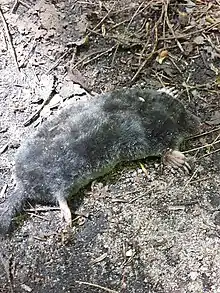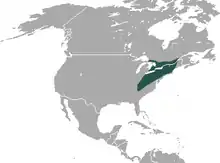Hairy-tailed mole
The hairy-tailed mole (Parascalops breweri), also known as Brewer's mole, is a medium-sized North American mole. It is the only member of the genus Parascalops.[1] The species epithet breweri refers to Thomas Mayo Brewer, an American naturalist.
| Hairy-tailed mole[1] | |
|---|---|
 | |
| Scientific classification | |
| Domain: | Eukaryota |
| Kingdom: | Animalia |
| Phylum: | Chordata |
| Class: | Mammalia |
| Order: | Eulipotyphla |
| Family: | Talpidae |
| Tribe: | Scalopini |
| Genus: | Parascalops True, 1894[3] |
| Species: | P. breweri |
| Binomial name | |
| Parascalops breweri (Bachman, 1842) | |
 | |
| Hairy-tailed mole range | |
| Synonyms[4] | |
| |
Taxonomy
Despite inhabiting North America, studies indicate that it is not closely related to the two other North American scalopine moles (Scalopus and Scapanus), but rather to the two Chinese scalopine moles (Scapanulus and Alpiscaptulus). This indicates that the two Chinese moles likely descend from a migration from North America back into Eurasia, where the scalopine moles originated. Some studies have suggested placing Parascalops, Scapanulus, and Alpiscaptulus into a single subtribe Parascalopina.[6]
Appearance
_(7748318398).jpg.webp)
This animal has dark grey fur with lighter underparts, a pointed nose and a short, hairy tail.[7] It is about 15 centimeters (5.9 in) in length, including a 3-centimeter-long (1.2 in) tail, and weighs about 55 grams (1.9 oz).[7] Its front paws are broad and spade-shaped, specialized for digging.[8] It has 44 teeth. Its eyes are covered by fur and its ears are not external.[8] Its feet and snout are pinkish, but become white in older animals.[7] Several adaptations to living primarily underground can be seen in the hairy-tailed mole. Its pelage is very dense and silky, and its feet are broad, flat, and heavy.[8] Moles rely very little on their eyesight and have very small optic nerves.[9] To accommodate its lack of vision, the hairy-tailed mole has sensitive whiskers and hairs on the tip of its nose and feet to feel its surroundings.[8]
Habitat
It is found in forested and open areas with dry loose soils in eastern Canada and the northeastern United States.[2] Since it is a fossorial mammal, it needs moist but well-drained soil so that it can dig easily.[7] The hairy-tailed mole prefers deciduous and coniferous woods, oldfields, and roadsides.[7][2]
Behavior
The hairy-tailed mole is cathemeral.[7] Since it lives primarily underground in shallow tunnels it can forage throughout the day and will also forage on the ground's surface at night.[7] The hairy-tailed mole is more active near the surface during warmer summer months and digs deeper underground in the cooler fall and winter months.[7]
This mole spends most of its time underground, foraging in shallow burrows for insects and their larvae and earthworms.[2] It emerges at night to feed. It is active year-round. Predators include owls, foxes and large snakes.[10]
This animal is mainly solitary except during mating in early spring.[10] The female has a litter of 4 to 5 young in a deep burrow.[7][2] This mole may live 3 to 4 years.[10]
Diet
Hairy-tailed moles are insectivores and have been shown to starve if vegetable matter is the only food source available.[10] The hairy-tailed mole's diet is mostly grubs, earthworms, beetle larvae, slugs, and ants, particularly when other food sources are not available.[2][10]
References
- Hutterer, R. (2005). "Order Soricomorpha". In Wilson, D.E.; Reeder, D.M (eds.). Mammal Species of the World: A Taxonomic and Geographic Reference (3rd ed.). Johns Hopkins University Press. p. 301. ISBN 978-0-8018-8221-0. OCLC 62265494.
- Cassola, F. (2017) [errata version of 2016 assessment]. "Parascalops breweri". IUCN Red List of Threatened Species. 2016: e.T41469A115188181. doi:10.2305/IUCN.UK.2016-3.RLTS.T41469A22322790.en.
- True, Frederick W. (1894). "Diagnoses of New North American Mammals". Proceedings of the United States National Museum. 17 (999): 242. doi:10.5479/si.00963801.999.241.
- Hallett, James G. (1978). "Parascalops breweri". Mammalian Species (98): 1–4. doi:10.2307/3503954. JSTOR 3503954. S2CID 253940042.
- Bachman, J. (1843). "Observations on the Genus Scalops, (Shrew Moles,) with Descriptions of the Species found in North America". Boston Journal of Natural History. 4 (1): 32–34.
- Chen, Zhong-Zheng; He, Shui-Wang; Hu, Wen-Hao; Song, Wen-Yu; Onditi, Kenneth O; Li, Xue-You; Jiang, Xue-Long (2021-01-08). "Morphology and phylogeny of scalopine moles (Eulipotyphla: Talpidae: Scalopini) from the eastern Himalayas, with descriptions of a new genus and species". Zoological Journal of the Linnean Society. 193 (2): 432–444. doi:10.1093/zoolinnean/zlaa172. ISSN 0024-4082.
- Reid, Fiona (2006). A field guide to mammals of North America (The Peterson field guide series) (4th ed.). New York, New York: Houghton Mifflin Company. pp. 387–388. ISBN 978-0-395-93596-5.
- "North American Mammals: Parascalops breweri : Image Information". naturalhistory.si.edu. Archived from the original on 2018-06-25. Retrieved 2016-12-08.
- Leitch, Duncan B.; Sarko, Diana K.; Catania, Kenneth C. (2014-09-01). "Brain Mass and Cranial Nerve Size in Shrews and Moles". Scientific Reports. 4: 6241. Bibcode:2014NatSR...4E6241L. doi:10.1038/srep06241. ISSN 2045-2322. PMC 4150104. PMID 25174995.
- "Parascalops breweri (hairy-tailed mole)". Animal Diversity Web. Retrieved 2016-12-08.
